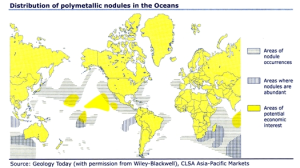Mains – 23rd Nov 23
Deep Sea Mining
Why in news?
- The International Seabed Authority – the United Nations body that regulates the world’s ocean floor – is preparing to resume negotiations that could open the international seabed for mining, including for materials critical for the green energy transition.
| What is International Seabed?
The seabed and ocean bottom outside of the purview of sovereign jurisdiction are referred to as the international seabed. It is a sizable region of the ocean that makes up around 54% of the entire oceanic surface area. According to UNCLOS, these resources belong to all people and should be managed for their mutual benefit.
About International Seabed Authority (ISA): · ISA is an autonomous international organization established under the 1982 United Nations Convention on the Law of the Sea (UNCLOS). · Its primary mandate is to “organize, regulate, and control” all mineral-resource related activities in the Area (the seabed and ocean floor and the subsoil thereof, beyond the limits of national jurisdiction) “for the benefit of humankind as a whole.” · It came into existence in November 1994, upon the entry into force of the 1982 Convention. It became fully operational as an autonomous international organization in June 1996. · Headquarter – Kingston, Jamaica. · Functions:
United Nations Convention on the Law of the Sea (UNCLOS): · United Nations Convention on the Law of the Sea (UNCLOS) 1982, also known as Law of the Sea divides marine areas into five main zones namely- Internal Waters, Territorial Sea, Contiguous Zone, Exclusive Economic Zone (EEZ) and the High Seas. · UNCLOS is the only international convention which stipulates a framework for state jurisdiction in maritime spaces. It provides a different legal status to different maritime zones. · It provides the backbone for offshore governance by coastal states and those navigating the oceans. It not only zones coastal states’ offshore areas but also provides specific guidance for states’ rights and responsibilities in the five concentric zones.
|
Deep Sea:
- The deep sea is broadly defined as the ocean depth where light begins to fade, at an approximate depth of 200 metres (656 feet) or the point of transition from continental shelves to continental slopes.
- Conditions within the deep sea are a combination of low temperatures, darkness and high pressure.
- The deep sea is considered the least explored Earth biome as the extreme conditions make the environment difficult to access and explore.
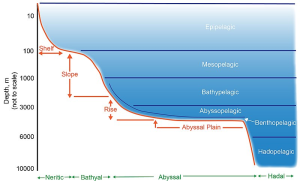
- Organisms living within the deep sea have a variety of adaptations to survive in these conditions. Organisms can survive in the deep sea through a number of feeding methods including scavenging, predation and filtration, with a number of organisms surviving by feeding on marine snow. Marine snow is organic material that has fallen from upper waters into the deep sea.
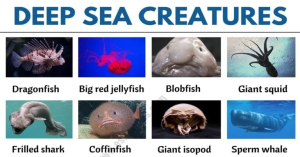
What is Deep Sea Mining?
- Deep-sea mining is the process of extracting and often excavating mineral deposits from the deep seabed. The deep seabed is the seabed at ocean depths greater than 200m, and covers about two-thirds of the total seafloor.
- There are three types of such mining:
i. taking deposit-rich polymetallic nodules off the ocean floor,
ii. mining massive seafloor sulphide deposits and
iii. stripping cobalt crusts from rock.
- Research suggests deep-sea mining could severely harm marine biodiversity and ecosystems. Despite this, there is growing interest in the mineral deposits of the seabed. This is said to be due to depleting terrestrial deposits of metals such as copper, nickel, aluminium, manganese, zinc, lithium and cobalt. Demand for these metals is also increasing to produce technologies like smartphones, wind turbines, solar panels and batteries.
- The nodules deposits and crusts contain materials, such as nickel, rare earths, cobalt and more, that are needed for batteries and other materials used in tapping renewable energy and also for everyday technology like cell phones and computers.

| Nodules:
· Geologically speaking, nodules are defined as round or spherical concretions of rock. In marine geology, more specifically, the term usually refers to manganese nodules or polymetallic nodules. · Polymetallic nodules are small potato-like rounded accretions largely porous nodules found in abundance carpeting the sea floor of world oceans in deep sea. · Besides manganese and iron, they contain nickel, copper, cobalt, lead etc which are of economic and strategic importance. · They can occur at any depth, but the highest concentrations have been found between 4,000 and 6,000m.
|
How is deep sea mining regulated now?
- Countries manage their own maritime territory and exclusive economic zones, while the high seas and the international ocean floor are governed by the United Nations Convention on the Law of the Seas.
- Under the treaty, the seabed and its mineral resources are considered the “common heritage of mankind” that must be managed in a way that protects the interests of humanity through the sharing of economic benefits, support for marine scientific research, and protecting marine environments.
Why is there pressure on the ISA to establish regulations now?
- In 2021 the Pacific Island nation of Nauru — in partnership with mining company Nauru Ocean Resources Inc — applied to the ISA to exploit minerals in a specified deep-sea area.
- According to the United Nations treaty, this application triggered a clause that requires the ISA to finalize regulations for deep sea mining by July 2023.
- If the regulations are not completed by then, Nauru has the right to submit an application for mining without any specific rules and regulations governing the process.
- If the ISA fails to approve the regulations, other countries and private companies can start applying for temporary licenses to engage in deep sea mining.
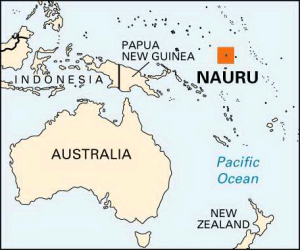
What are the environmental concerns?
- Disturbance of the seafloor: The digging and gauging of the ocean floor by machines can alter or destroy deep-sea habitats. This leads to the loss of species, many of which are found nowhere else, and the fragmentation or loss of ecosystem structure and function.
- Sediment plumes: Deep-sea mining will stir up fine sediments on the seafloor, creating plumes of suspended particles. This is exacerbated by mining ships discharging waste water at the surface. Scientists are concerned these particles may disperse for hundreds of kilometres, take a long time to resettle on the seafloor, and affect ecosystems and commercially important or vulnerable species.
- For instance, such plumes could smother animals, harm filter-feeding species, and block animals’ visual communication.
- Pollution: Species such as whales, tuna and sharks could be affected by noise, vibrations and light pollution caused by mining equipment and surface vessels, as well as potential leaks and spills of fuel and toxic products.
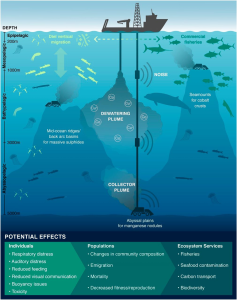
What can be done?
At the IUCN World Conservation Congress in Marseille (September 2021), IUCN Members adopted Resolution 122 to protect deep-ocean ecosystems and biodiversity through a moratorium on deep-sea mining unless and until a number of conditions are met. These include:
- The risks of mining are comprehensively understood and effective protection can be ensured.
- Rigorous and transparent impact assessments are conducted based on comprehensive baseline studies.
- The Precautionary Principle and the ‘Polluter Pays Principle’ are implemented.
- Policies incorporating circular economic principles to reuse and recycle minerals have been developed and implemented.
- The public are consulted throughout decision-making.
- The governance of deep-sea mining shall be transparent, accountable, inclusive, effective and environmentally responsible.
- Reliance on metals from mining can be reduced by redesigning, reusing and recycling. In addition, research should focus on creating more sustainable alternatives to their use because deep-sea mining could irreparably harm marine ecosystems, and limit the many benefits the deep sea provides to humanity.
| International Union for Conservation of Nature (IUCN):
· It is a membership Union uniquely composed of both government and civil society organisations. · Created in 1948, IUCN is the global authority on the status of the natural world and the measures needed to safeguard it. · It is headquartered in Switzerland. · It provides public, private and non-governmental organisations with the knowledge, tools and projects that enable societies, economies and nature to thrive together. These include data, assessments and analysis, trusted standards, neutral convening fora, and capacity-building resources. · The IUCN Red List of Threatened Species, is the world’s most comprehensive inventory of the global conservation status of plant and animal species. |
What is India’s Deep Ocean Mission?
India was the first country to receive the status of a ‘Pioneer Investor‘ in 1987 and was given an area of about 1.5 lakh sq. km in the Central Indian Ocean Basin (CIOB) for nodule exploration. In 2002, India signed a contract with the ISA and after complete resource analysis of the seabed 50% was surrendered and the country retained an area of 75,000 sq. km.
Deep Ocean Mission is being implemented by Ministry of Earth Sciences with a view to explore deep ocean for resources and develop deep sea technologies for sustainable use of ocean resources. The Mission consists of the following six major components –
- Development of Technologies for Deep Sea Mining, and Manned Submersible: A manned submersible (MATSYA 6000) will be developed to carry three people to a depth of 6000 metres in the ocean with suite of scientific sensors and tools.
- Development of Ocean Climate Change Advisory Services: A suite of observations and models will be developed to understand and provide future projections of important climate variables on seasonal to decadal time scales under this proof of concept component.
- Technological innovations for exploration and conservation of deep-sea biodiversity: Bio-prospecting of deep sea flora and fauna including microbes and studies on sustainable utilization of deep sea bio-resources will be the main focus.
- Deep Ocean Survey and Exploration: The primary objective of this component is to explore and identify potential sites of multi-metal Hydrothermal Sulphides mineralization along the Indian Ocean mid-oceanic ridges.
- Energy and freshwater from the Ocean: Studies and detailed engineering design for offshore Ocean Thermal Energy Conversion (OTEC) powered desalination plant are envisaged in this proof of concept proposal.
- Advanced Marine Station for Ocean Biology. This component is aimed as development of human capacity and enterprise in ocean biology and engineering.
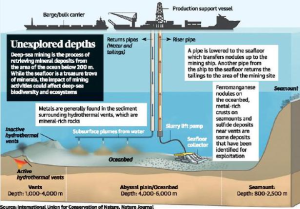
According to a release from the Ministry of Earth Sciences, the estimated polymetallic nodule resource potential in this area is 380 million tonnes (MT), containing 4.7 MT of nickel, 4.29 MT of copper, 0.55 MT of cobalt and 92.59 MT of manganese.
Role of Deep Ocean Mission in Blue Economy:
- It aims of the mission is to explore and extract polymetallic nodules.
- It entails developing a suite of observations and models to understand and provide future projections of important climate variables on seasonal to decadal time scales.
- It will explore and identify potential sites of multi-metal Hydrothermal Sulphides mineralization along the Indian Ocean mid-oceanic ridges.
- It will translate research into industrial application and product development through on-site business incubator facilities.
- Apart from this, oceans are also a storehouse of energy, food, medicines, minerals, modulator of weather and climate and underpin life on Earth.
India’s other Blue Economy Initiatives:
- Samudrayaan Mission: The mission is aimed at sending three personnel to 6000-metre depth in a vehicle called ‘MATSYA 6000’ for the exploration of deep-sea resources like minerals. It is India’s first unique manned ocean mission and is a part of the Rs 6000-crores Deep Ocean Mission.
- India-Norway Task Force on Blue Economy for Sustainable Development: It was inaugurated jointly by both the countries in 2020 to develop and follow up joint initiatives between the two countries.
- Sagarmala Project: The Sagarmala project is the strategic initiative for port-led development through the extensive use of IT enabled services for modernization of ports.
- O-SMART: India has an umbrella scheme by the name of O-SMART which aims at regulated use of oceans, marine resources for sustainable development.
- Integrated Coastal Zone Management: It focuses on conservation of coastal and marine resources, and improving livelihood opportunities for coastal communities etc.
- National Fisheries Policy: India has a National Fisheries policy for promoting ‘Blue Growth Initiative’ which focuses on sustainable utilization of fisheries wealth from marine and other aquatic resources.
| Considering the importance of the oceans on sustainability, the UN has declared the decade, 2021-2030 as the Decade of Ocean Science for Sustainable Development. |
MANIPUR DISCUSSION NOT ALLOWED IN RAJYA SABHA UNDER RULE 267
Why in news?
- On the first day of the monsoon session, the Opposition wanted to discuss Manipur under Rule 267.
- However, the Chairman of the Rajya Sabha said the government was keen and agreeable for discussion under Rule 176 for Short Duration Discussion.
What is Rule 267?
- Under this rule, the House can suspend all of its pending business in order to focus on a matter that requires immediate attention.
Significance of this rule
- Because all other businesses would be put on hold to discuss the issue of national importance, any discussion under Rule 267 takes on great significance in Parliament.
- There is no other type of discussion that calls for the suspension of other activities.
- Further, the government will be required to respond to the issue during the Rule 267 discussions.
Why has Rule 267 been a contentious issue?
- The Opposition has complained that none of its notices under Rule 267 are being taken up.
- In the winter session, the Chairman of Rajya Sabha had rejected eight such notices within two days. These notices contained matters such as the border issue with China and rising prices of essential commodities.
Short Duration Discussion under the Rule 176
- The government, on the other hand, is against proceeding with Rule 267, and has been insisting on a short-duration discussion under Rule 176.
- Under this provision, an MP can raise a discussion on a matter of urgent public importance.
- The time for the discussion is allocated by the Business Advisory Committee.
- The MP will need to give notice specifying the matter to be raised and the reasons for doing so.
- Once the Chairman admits the notice, the rules say he, in consultation with the Leader of the Council, will fix the date on which such matter may be taken up for discussion and allow such time for discussion, not exceeding two and a half hours.
- The MP raises the matter and this is followed by other MPs discussing the issue. The Minister-in-charge responds at the end of the discussion.
Adjournment Motion vs Rule 267
- Adjournment motion is to take up for discussion a subject of urgent nature, not just discussion; the adjournment motion has an element of censure. That is the privilege of Lok Sabha because LS can bring down a government which the RS cannot do, that is why there is no adjournment motion in Rajya Sabha.
- Rule 267 is to suspend a particular rule in relation to a business which is listed in the agenda. For instance, if a Bill is to be introduced, it would be listed, but if a rule is coming in the way, 267 is aimed at suspending the rule.

